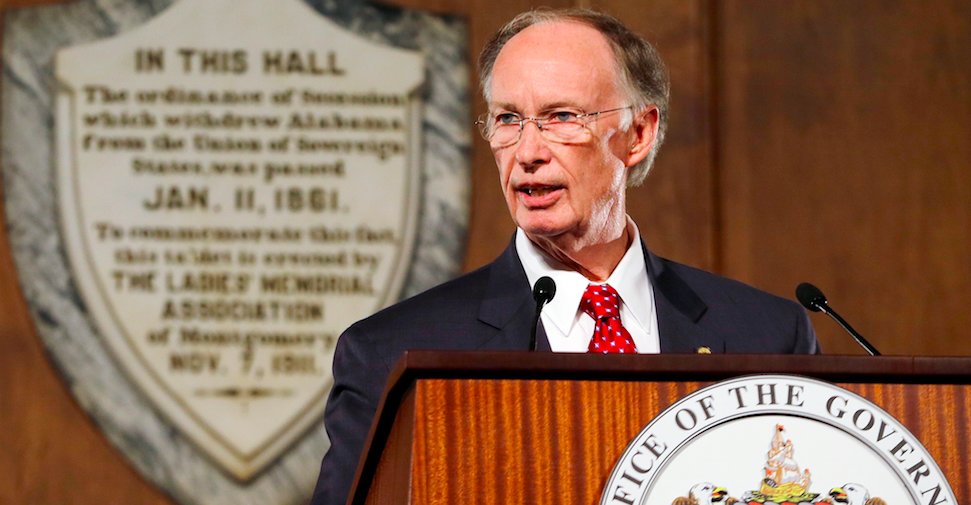
MONTGOMERY, Ala. — Public campaign finance disclosures show Governor Robert Bentley (R-AL) received $45,000 in combined donations from groups affiliated with Alabama Education Association and Alabama Hospital Association on the same day he announced his $541 million tax increase plan in early 2015.
A February 27th, 2015 finance report filed by Governor Bentley’s campaign shows it received $25,000 from A-VOTE, the AEA’s Political Action Committee (PAC) and $20,000 from the Alabama Hospital Association PAC.
According to a campaign finance legal expert Yellowhammer spoke with on background, it is perfectly lawful and not unusual for elected officials to continue raising campaign funds after their elections, as long as they are working to retire debt incurred by the campaign. In Governor Bentley’s case, he loaned his campaign around $500,000 during the 2014 cycle. His campaign account currently contains $604,260.
The excess between his debt and what he has left in his war chest cannot be used for a future federal campaign, or be given to other candidates or PACs in the state.
So, besides paying back his debt, what can the governor put the surplus toward? Not a whole lot, apparently.
Allowed expenses could include Christmas cards and other letters or cards to supporters, political trips the state cannot pay for (e.g. if the governor wanted to go to the 2016 Republican Nominating Convention in Cleveland), or paying political consultants for work concerning the wrapping up of the campaign.
Rebekah Mason, a spokesman for the governor’s campaign, told the Anniston Star the timing of the donations is purely coincidental; reports for any campaign contributions are due the last Friday of the month.
However, both organizations are major stakeholders in the two most prominent issues currently facing state government — the General Fund budget debate and a potential Medicaid expansion.
The $25,000 check from the AEA was reportedly written and approved on February 13th by the teachers’ union’s recently-ousted leader Henry Mabry. A representative from the AEA told reporters she didn’t know “what the thought process was about that led to this $25,000.”
The AEA, though it has lost much of its clout, is still an ardent opponent of conservative budgeting reforms, including consolidating the General Fund and Education Trust Fund or eliminating or reducing the vast number of earmarks in the state’s budgeting process. Alabama is one of only three states with two separate budgets and earmarks by far the highest percentage of its tax revenue (91 percent) of any state in the country. The AEA pushed to put the current budgeting system in place and has fought to maintain it for decades.
According to a spokesperson for the Hospital Association, their PAC made the donation on February 11th after a telephone conversation with Governor Bentley on the need to retire his campaign’s debt.
The Hospital Association is a significant proponent for Medicaid expansion, having funded studies and campaigns looking to sway the state’s leaders toward expanding the program by increasing the number of people on taxpayer-funded health insurance.
Throughout his first term, Governor Bentley assured voters he would not expand Medicaid, but has softened his stance somewhat in recent months, intimating that he is open to a modified version of the expansion similar to what a handful of other Republican-lead states have attempted.
Pennsylvania and Arkansas, which are also led by Republican governors, expended the program by funneling federal tax dollars through the state government and into private insurers. They then use those taxpayer dollars to cover uninsured individuals up to 138 percent of the federal poverty level, the same ultimate outcome as Medicaid expansion under ObamaCare. The difference is that by receiving a “waiver” from the Obama administration, Republican governors have been able to participate in ObamaCare’s Medicaid expansion while selling to their conservative constituents as something completely different. In Pennsylvania they call it the “Healthy PA” plan. In Arkansas it’s commonly referred to as the “private option.”
Governor Bentley signed an executive order in early April creating the Alabama Healthcare Improvement Task Force to “address ways to improve the health” of Alabamians. A cursory look at the 38 men and women appointed to the task force shows it to be stacked with advocates for Medicaid expansion.
While the majority of Republicans stand adamantly against expanding the already-beleaguered Medicaid program, the governor has perhaps grown accustomed to advocating what he believes to be best for the state, despite pushback from other members of his party.
Like this article? Hate it? Follow me and let me know how you feel on Twitter!
— Elizabeth BeShears (@LizEBeesh) January 21, 2015
Don’t miss out! Subscribe today to have Alabama’s leading headlines delivered to your inbox.